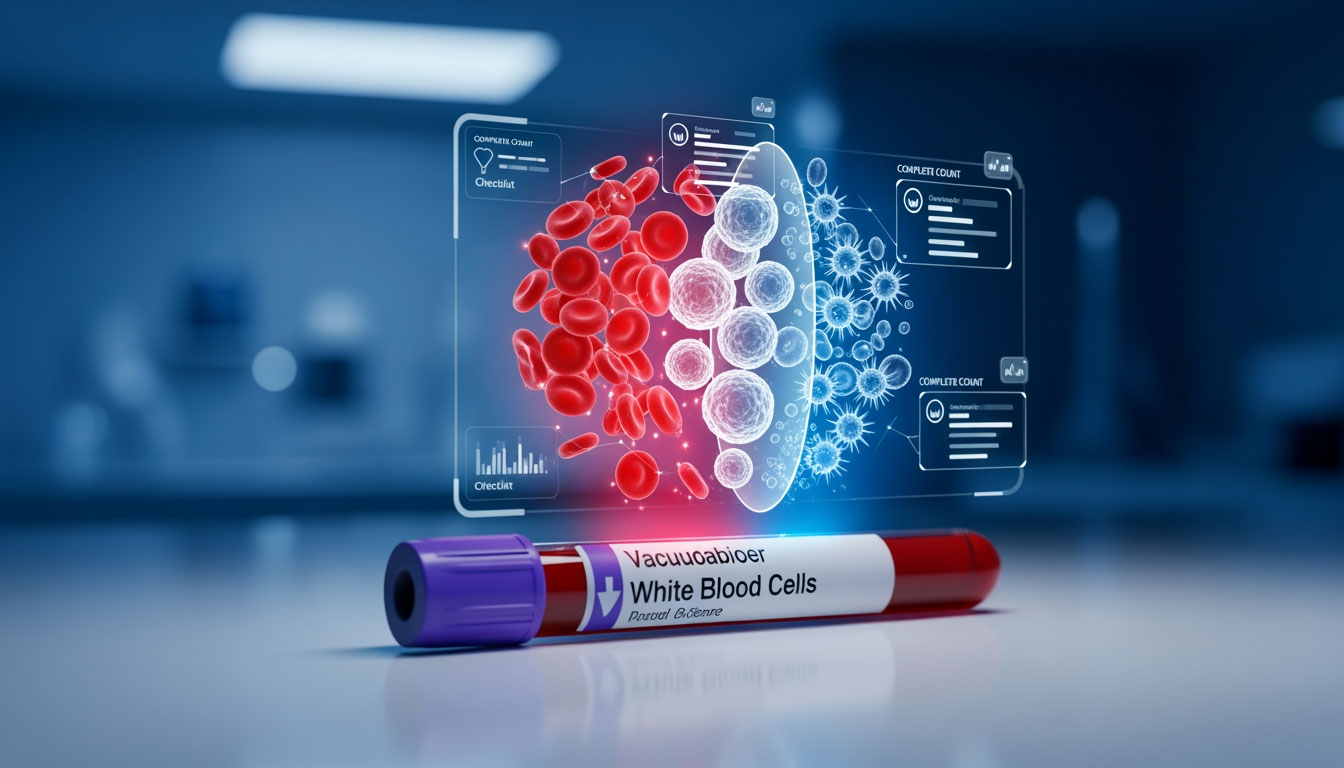If you have ever sat on the exam table at a primary care physician’s office in the USA for an annual physical, you have likely experienced the routine. The nurse checks your blood pressure, measures your weight, and eventually draws a few vials of blood. A few days later, you receive a report filled with acronyms and numbers that look more like a complex code than a medical diagnosis. Among all those tests, the CBC blood test is the single most common blood work ordered by medical professionals. Yet, despite its frequency, few patients truly understand what happens to their blood after it is drawn or what those numbers on the final report actually mean regarding their longevity and health.
A CBC blood test, technically known as a Complete Blood Count, is a comprehensive diagnostic panel that serves as a window into your body’s systemic health. It evaluates the cells that circulate in your bloodstream, which are responsible for keeping your tissues alive and defending you against illness. Specifically, what is a cbc blood test designed to measure? It calculates the quantity, quality, shape, and size of three major types of cells: red blood cells (the oxygen carriers), white blood cells (the immune defenders), and platelets (the clotting agents). By analyzing these components, doctors can detect a wide variety of disorders, ranging from common nutritional deficiencies like anemia and active issues like infection to serious conditions such as leukemia.

This guide serves as a comprehensive resource to help you navigate the complexities of this essential medical tool. We will explore the biology behind the test, how to interpret your specific results, the technology used in modern labs, and why this specific screening is the absolute cornerstone of preventative healthcare in the United States.
Why Do Doctors Order a Complete Blood Count?

The complete blood count test is not reserved solely for people who feel ill. It is a foundational tool in modern medicine because your blood is essentially a biological highway that connects every organ in your body. It transports nutrients, hormones, oxygen, and immune cells to where they are needed most. Consequently, changes in the composition of your blood often reflect changes in your general health long before you feel physical symptoms.
Routine Health Monitoring and Baselines
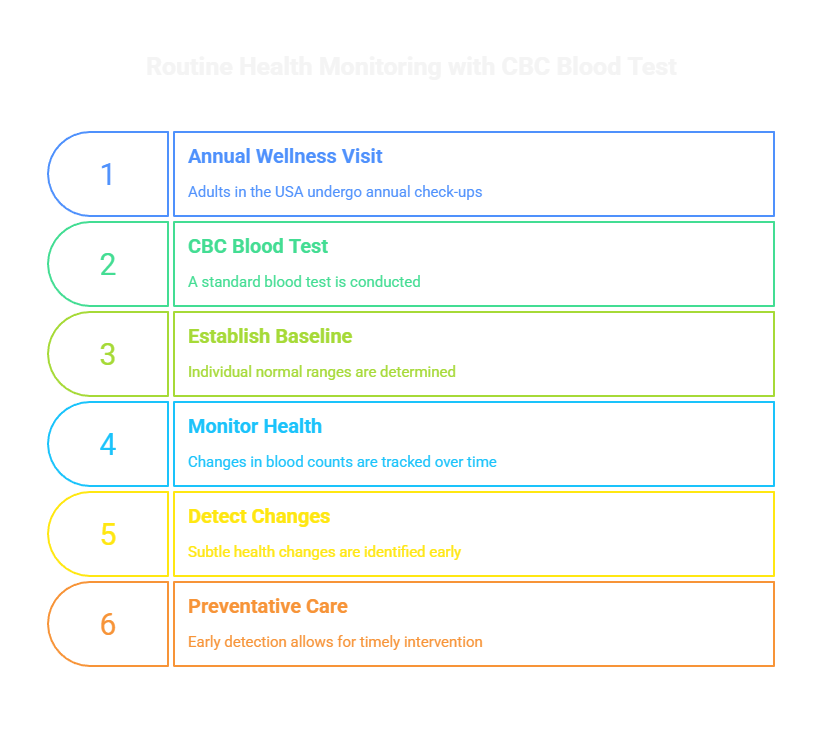
For most adults in the USA, the cbc blood test is a standard component of an annual wellness visit. Establishing a baseline is critical for long-term health management. Every individual is different. Your “normal” might be on the lower end of the standard spectrum, while someone else’s might be on the higher end. If your doctor knows what your normal range looks like when you are healthy, it becomes much easier to spot subtle changes when you are unwell. This is preventative care at its most effective. It allows physicians to catch trending declines in cell counts before they drop into dangerous territories.
Diagnostic Detective Work
When a patient presents with specific but vague symptoms, the cbc blood test purpose shifts from monitoring to active investigation. Symptoms like unexplained fatigue, persistent weakness, low-grade fever, or easy bruising are nonspecific, meaning they could be caused by dozens of different illnesses. The CBC acts as a compass, pointing the doctor in the right direction.
- Profound fatigue often leads to a hemoglobin test review to check for anemia.
- Recurrent fevers prompt a detailed review of the white blood cell count to look for hidden infection or autoimmune inflammation.
- Unexplained bleeding or bruising triggers an immediate platelet count analysis to ensure clotting mechanisms are intact.
Monitoring Medical Treatments

Patients diagnosed with chronic conditions or those undergoing aggressive treatments often require frequent monitoring to ensure their safety. For example, chemotherapy drugs are powerful agents designed to kill rapidly dividing cancer cells. Unfortunately, bone marrow cells also divide rapidly, making them “innocent bystanders” in the treatment. This can suppress the bone marrow’s ability to produce new blood cells. A regular complete blood count test ensures that drug dosages are safe and that the body is recovering appropriately between treatment cycles. Similarly, patients on long-term antibiotics or immunosuppressants for conditions like Rheumatoid Arthritis need regular checks to ensure their white blood cell counts remain high enough to fight off potential infections.
What Does a CBC Blood Test Check For? (Detailed Components)
To truly answer what is a cbc blood test, we must break down the fluid itself. Blood is not merely a red liquid. It is a living tissue composed of liquid plasma and solid cellular components. The plasma carries electrolytes, proteins, and water, while the cbc test focuses entirely on the solid parts: the cells produced within the soft, spongy center of your bones known as bone marrow.
Red Blood Cells (RBC): The Oxygen Carriers
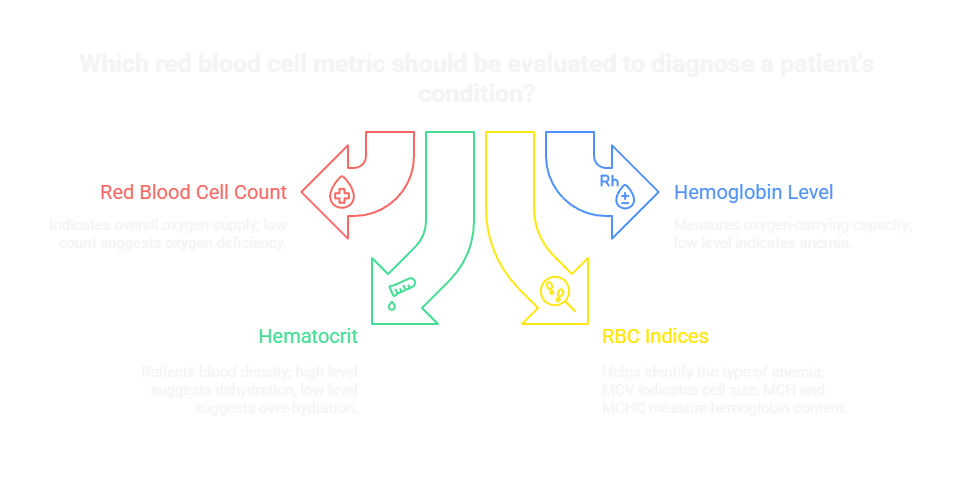
Red blood cells, medically termed erythrocytes, are the most abundant cells in your body. Shaped like biconcave discs (like a donut without the hole punched all the way through), they are designed perfectly for their primary job: transporting fresh oxygen from your lungs to your tissues and carrying carbon dioxide back to your lungs to be exhaled.
The Red Blood Cell Count
This metric simply counts the actual number of red cells in a specific volume of blood. A low red blood cell count generally indicates that your body is not getting enough oxygen, which manifests physically as fatigue, dizziness, or shortness of breath.
Hemoglobin (Hb)
Inside every red blood cell is a complex protein called hemoglobin. This molecule contains iron, which allows it to bind to oxygen. When a doctor orders a hemoglobin test, they are checking the oxygen-carrying capacity of your blood. It is possible to have a normal number of red cells, but if those cells lack enough hemoglobin (often due to low iron), you will still experience the symptoms of being anemic.
Hematocrit (Hct)
The hematocrit test measures the volume or space that red blood cells take up in your blood compared to the total volume. Think of it as the density or “thickness” of the cells.
- If you are dehydrated, your plasma volume drops (less liquid), making your hematocrit look artificially high because the cells are more concentrated.
- If you are over-hydrated or have fluid overload, it might look slightly lower.
This value is crucial for diagnosing severe blood loss, hydration issues, or conditions like Polycythemia Vera, where the blood becomes too thick and sludge-like.
RBC Indices (MCV, MCH, MCHC)
These technical acronyms are vital for diagnosing the type of anemia a patient has, saving time on further testing.
- MCV (Mean Corpuscular Volume): This measures the average physical size of your red blood cells. Vitamin B12 and Folate deficiencies cause cells to grow abnormally large (macrocytic anemia). Conversely, Iron deficiency causes them to become small and stunted (microcytic anemia).
- MCH (Mean Corpuscular Hemoglobin): This measures the average amount of hemoglobin in a single red blood cell.
- MCHC (Mean Corpuscular Hemoglobin Concentration): This measures the concentration of hemoglobin in a given volume of packed red blood cells.
White Blood Cells (WBC): The Immune Defense
Your white blood cell count is a direct measure of your immune system’s readiness and activity. These cells, or leukocytes, are the mobile defense units that protect the body against foreign invaders like bacteria, viruses, fungi, and parasites.

Total WBC Count
This is the aggregate number of all immune cells in the sample. A high number usually signals that the body is fighting something, creating more soldiers for the war effort. A low number might indicate the marrow is failing to produce them.
The Importance of a CBC with Differential
A standard CBC gives the total count, which is helpful but nonspecific. However, a cbc with differential breaks that number down into five specific types of white blood cells. This is critical for precise diagnosis, as different enemies trigger different defenders.
- Neutrophils: These are the “first responders” of the immune system. They make up the majority of your white cells and are primarily responsible for killing bacteria and fungi.
- Lymphocytes: These are the “intelligence officers.” They include T-cells and B-cells that target viruses and create antibodies to remember past infections.
- Monocytes: These are the “clean-up crew.” They circulate for a short time and then enter tissues to become macrophages, eating up dead cells and debris.
- Eosinophils: These specialized cells target larger parasites and are heavily involved in allergic reactions and asthma.
- Basophils: These are the rarest type. They release histamine and heparin, playing a role in allergic responses and inflammation control.
When you ask what is a cbc blood test capable of detecting, the “differential” is what allows doctors to distinguish between a sinus infection (likely bacterial) and a viral flu (viral).
Platelets (PLT): The Clotting Factors

Platelets, or thrombocytes, are not actually complete cells but tiny fragments of cytoplasm released from bone marrow. They are the body’s emergency repair squad. When a blood vessel is damaged or cut, platelets rush to the site and bind together to form a plug, initiating the coagulation cascade to stop the bleeding.
- A low platelet count (thrombocytopenia) puts you at risk for dangerous internal bleeding or inability to stop bleeding after a minor cut.
- A high count (thrombocytosis) can lead to dangerous, spontaneous clots that may cause strokes or heart attacks.
Mean Platelet Volume (MPV)
Similar to MCV for red cells, the MPV measures the average size of your platelets. Newer platelets tend to be larger. A high MPV suggests your bone marrow is rapidly producing new platelets, perhaps recovering from a recent loss.
Understanding CBC Blood Test Results
Interpreting your lab report can be an intimidating experience. You will see a column for your specific results and a column for the “Reference Range.” It is important to note that “normal” can vary slightly depending on the specific automated hematology analyzer the lab uses and the population data they reference.
Below is a standard guide for cbc blood test normal range values typically used in the USA.
CBC Blood Test Normal Range Chart
| Component | Abbreviation | Normal Range (Adult Men) | Normal Range (Adult Women) | Primary Function |
| Red Blood Cell Count | RBC | 4.32 – 5.72 trillion/L | 3.90 – 5.03 trillion/L | Oxygen transport |
| Hemoglobin | Hb / Hgb | 13.5 – 17.5 g/dL | 12.0 – 15.5 g/dL | Oxygen carrier protein |
| Hematocrit | Hct | 38.8 – 50.0% | 34.9 – 44.5% | Blood volume percentage |
| White Blood Cell Count | WBC | 3,500 – 10,500 /mcL | 3,500 – 10,500 /mcL | Immune defense |
| Platelet Count | PLT | 150,000 – 450,000 /mcL | 150,000 – 450,000 /mcL | Blood clotting |
| Mean Corpuscular Vol | MCV | 80 – 100 fL | 80 – 100 fL | Average RBC size |
What Does a Low Count Mean?
When results fall below the established threshold, it generally indicates a deficiency in production within the bone marrow, a loss through bleeding, or an increase in destruction by the body itself.
- Low Hemoglobin/RBC: This is the clinical definition of anemia. It means your tissues are starving for oxygen. Common causes include iron deficiency, internal bleeding (such as from an ulcer), or kidney disease.
- Low WBC (Leukopenia): This leaves you vulnerable to infection. It can be caused by autoimmune disorders that attack white cells, bone marrow problems, or certain medications like antibiotics and chemotherapy.
- Low Platelets: This is often seen in viral infections, heavy alcohol use, Vitamin B12 deficiency, or autoimmune conditions like Lupus where the body mistakenly attacks its own platelets.
What Does a High Count Mean?

High numbers indicate the body is overproducing cells, usually in reaction to a stimulus, though sometimes due to a genetic variance.
- High WBC (Leukocytosis): This is the most common abnormality seen in urgent care. It typically signifies an active infection blood test result. It can also be caused by severe stress, steroid use, or tissue damage from burns.
- High RBC (Erythrocytosis): This can happen if you live at high altitudes where oxygen is thin, causing the body to compensate by making more carriers. It is also common in chronic smokers and people with sleep apnea.
- High Platelets: This is a marker of inflammation. It is often seen in rheumatoid arthritis, inflammatory bowel disease, or after the removal of the spleen.
What Conditions Does a Complete Blood Count Test Detect?
The cbc blood test is rarely a standalone diagnosis tool for every disease, but it is almost always the first step in identifying serious conditions. By analyzing the patterns and relationships in the data, doctors can narrow down complex medical mysteries.
Anemia Diagnosis and Classification
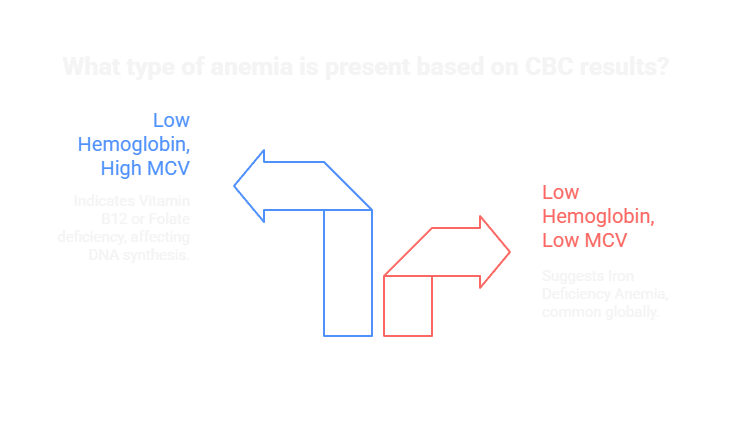
Anemia is not a single disease entity. It is a condition with many underlying causes, and the treatment depends entirely on the type. A complete blood count test helps doctors determine why you are anemic.
If the hemoglobin test is low and the MCV is low (small cells), it strongly suggests Iron Deficiency Anemia, the most common blood condition globally. This directs the doctor to look for blood loss or dietary issues.
Conversely, if the hemoglobin is low but the MCV is high (large cells), the doctor will look for Vitamin B12 or Folate deficiencies, which affect how DNA is built inside the cell. This distinction saves time and ensures patients get the right supplements immediately.
Infection and Immune Disorders
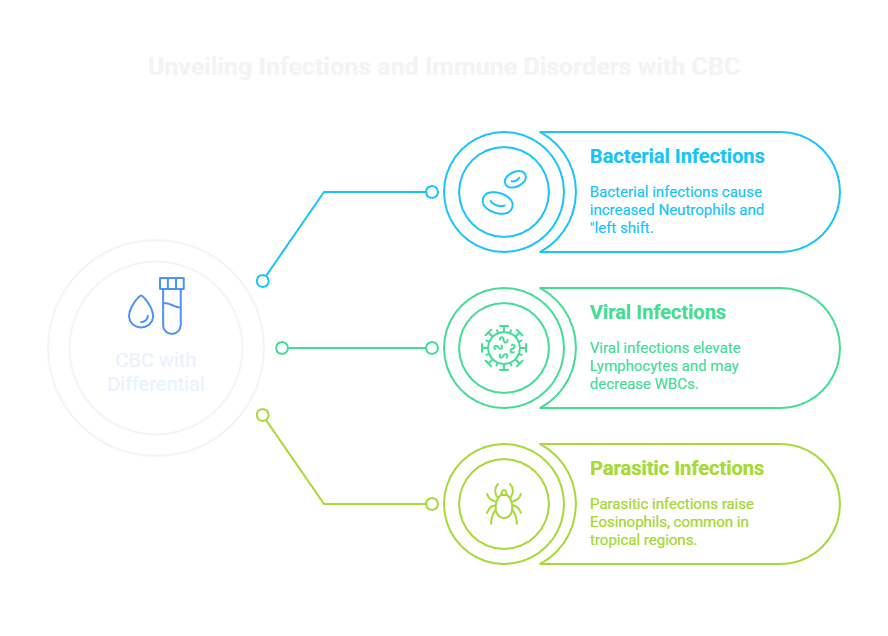
When a patient has a fever of unknown origin, the cbc with differential is invaluable.
- Bacterial Infections: Typically cause a spike in Neutrophils and an increase in “bands” (immature neutrophils), a phenomenon known as a “left shift.”
- Viral Infections: Often result in elevated Lymphocytes and sometimes a temporary drop in total WBCs as the virus suppresses the marrow.
- Parasitic Infections: Are relatively rare in the USA compared to tropical regions, but a high Eosinophil count can flag them immediately. It also flags severe allergic reactions.
Blood Cancer Detection
Can a cbc blood test detect cancer? While it cannot diagnose cancer definitively without a biopsy, it is arguably the most effective screening tool for blood cancer detection.

Leukemia, a cancer of the blood-forming tissues, often presents with specific chaotic patterns. Acute Leukemia might present with extremely high white blood cell count numbers combined with very low red blood cell count and platelet count numbers because the cancer cells are crowding out the healthy cells in the marrow. The presence of very immature cells, known as “blasts,” on a CBC report is a critical red flag that requires immediate referral to an oncologist or hematologist.
Chronic Kidney Disease and Heart Health
The kidneys produce a hormone called erythropoietin (EPO), which tells the bone marrow to make red blood cells. In patients with chronic kidney disease, this signal is lost, leading to a specific type of anemia called “anemia of chronic disease.” Regular cbc blood test monitoring helps nephrologists manage this complication. Furthermore, chronic inflammation markers seen in white blood cells are increasingly linked to cardiovascular risk, providing data on heart health.
CBC vs. Other Common Blood Tests
It is easy to confuse the acronyms on a lab requisition form. Patients often ask what is a cbc blood test compared to a metabolic panel. They are distinct tests that look at completely different body systems, yet they are often ordered together to provide a “holistic” view.
The following table outlines the key differences to help you understand your medical invoice.
Comparison: CBC vs. CMP vs. Lipid Panel
| Feature | CBC Blood Test | CMP (Comprehensive Metabolic Panel) | Lipid Panel |
| What it Measures | Cellular components (RBC, WBC, Platelets) | Chemicals, electrolytes, and enzymes in plasma | Cholesterol and Triglycerides |
| Primary Purpose | Checks immune system, oxygen transport, and clotting | Checks kidney function, liver function, and blood sugar | Assesses heart health and stroke risk |
| Fasting Required? | Generally No | Yes (usually 8-12 hours) | Yes (usually 9-12 hours) |
| Key Indicator For | Anemia, Infection, Leukemia | Diabetes, Kidney Failure, Liver Disease | Heart Disease, Arterial Blockage |
Understanding this distinction clarifies why a doctor might order multiple vials of blood during one visit. A cbc test tells them about the cells, while the CMP tells them about the fluid the cells swim in and how the organs are filtering that fluid.
How to Prepare for a CBC Blood Test
One of the advantages of the complete blood count test is its simplicity. Unlike specialized imaging or invasive procedures, the barrier to entry is low. However, there are still best practices to ensure your results are accurate.
Do You Need to Fast?
This is the most common question patients ask. Strictly speaking, what is a cbc blood test requirement regarding food? You do not need to fast for a standalone CBC. Eating breakfast will not change the number of red or white cells in your body, nor will it alter your hemoglobin.
However, physicians rarely order just a cbc blood test. It is frequently paired with a CMP (to check glucose) or Lipid panel (to check cholesterol), which do require fasting. Always clarify with your doctor. If your lab order says “CBC Only,” you are generally free to eat.
Hydration and Lifestyle Factors
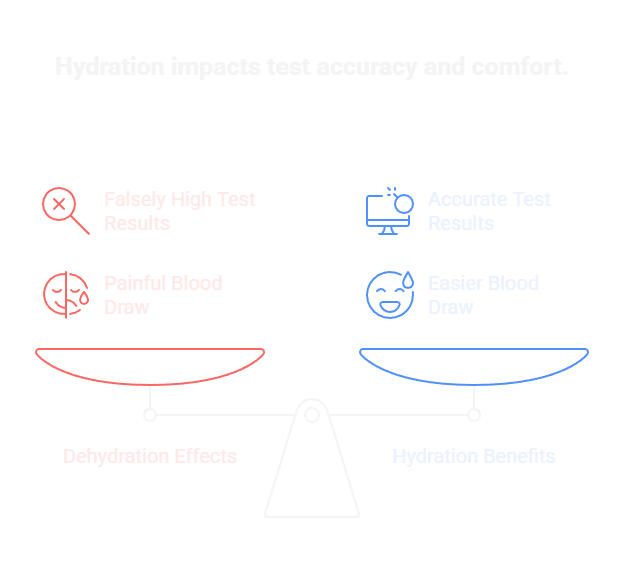
Hydration status plays a surprising role in your results. As mentioned in the hematocrit test section, dehydration reduces the liquid volume of your blood. This makes the cells appear more concentrated than they truly are, leading to a falsely high hematocrit or hemoglobin test result.
- Tip: Drink plenty of water before your appointment. Hydrated veins are also plumper and easier for the phlebotomist to access, making the blood draw less painful.
Certain supplements can also interfere with lab tests. For example, high doses of Biotin (often taken for hair and nail growth) can interfere with certain immunoassay tests, though it affects hormone tests more than the CBC. Still, it is wise to inform your doctor of all supplements you take.
The Phlebotomy Experience
For those nervous about needles, knowing what to expect can help. A tourniquet is applied to the upper arm to slow blood flow and swell the veins. The site is cleaned with alcohol. A small needle, often a “butterfly” needle for comfort, is inserted. The actual draw takes less than a minute. Once the needle is removed, pressure is applied to prevent bruising.
Cost and Insurance in the USA
For patients in the USA, the cbc blood test is affordable and widely covered.
- With Insurance: Most plans cover 100% of the cost as part of preventive care during an annual physical. For diagnostic purposes, standard copays apply.
- Without Insurance: The out-of-pocket cost is relatively low compared to other diagnostics. You can expect to pay between $15 and $50 depending on the lab and region.
- CPT Code: The medical billing code for a standard automated CBC is typically 85025 (with differential) or 85027 (without differential).
Advanced Considerations and Technology
The days of doctors counting cells through a microscope by hand are largely over. Today, what is a cbc blood test relies on sophisticated technology that ensures speed and precision.
Automated Hematology Analyzers
Modern laboratories use an automated hematology analyzer. These machines use flow cytometry and laser scattering to count thousands of cells in seconds. As cells pass through a laser beam single-file, they scatter light in specific patterns. The machine measures the size and internal complexity of each cell based on this light scatter to categorize them into red cells, white cells, or platelets. This ensures a level of accuracy and consistency that manual counting could never achieve.
The Role of AI in Hematology
Artificial intelligence is beginning to play a role in validating abnormal results. If an analyzer flags a sample as unusual—perhaps due to the presence of potential leukemia cells or clumped platelets—AI algorithms can now assist pathologists in identifying these cells faster. This integration of technology speeds up blood disorders diagnosis, allowing patients to start life-saving treatments sooner.
Summary & Key Takeaways
The cbc blood test is more than just a routine checklist item. It is a vital window into the biological workings of your body. From the oxygen delivery of your red blood cell count to the defensive capabilities of your white blood cell count and the repair mechanisms of your platelet count, this test tells the story of your systemic health.
Key Takeaways:
- Routine Necessity: Everyone should have a complete blood count test annually to establish a baseline.
- Diagnostic Power: It is the primary tool for detecting anemia, confirming infection, and screening for blood cancer detection.
- Interpretation Matters: A single number outside the normal range is not a panic signal. Doctors look at the trends and relationships between RBCs, WBCs, and platelets to form a diagnosis.
- Preparation: Stay hydrated. Fasting is usually not required unless other tests are ordered simultaneously.
- Context is Key: Your results are unique to you. Factors like age, biological sex, and even altitude can shift what is considered “normal.”
By understanding what is a cbc blood test and how to read your report, you become an active participant in your healthcare journey. Always keep copies of your lab work. Watching how your numbers change over the years is one of the best ways to stay proactive about your health and catch potential issues before they become life-altering problems.
Frequently Asked Questions (FAQs)
What is the most important part of a CBC test?
While all components are vital, doctors generally focus first on hemoglobin and white blood cell count when screening a patient. Hemoglobin indicates if you are anemic, which speaks to your energy levels and oxygen status. The white cell count indicates if your immune system is under stress or fighting an active threat. These two values provide the quickest snapshot of immediate health risks.
Can a CBC blood test detect cancer?
A cbc blood test is an essential screening tool for cancers of the blood and bone marrow, such as leukemia and lymphoma. It can reveal extremely high white blood cell counts or critically low platelet and red cell counts. However, it cannot diagnose solid tumors (like breast, lung, or colon cancer) directly. A biopsy is always required to confirm a cancer diagnosis, but the CBC often provides the first warning sign that something is wrong.
Why would a doctor order a CBC with differential?
Doctors order a cbc with differential when they suspect an infection, allergy, or immune issue. The differential breaks down the white blood cells into five specific types. This helps determine if an illness is bacterial (high neutrophils), viral (high lymphocytes), or allergic (high eosinophils). This distinction is crucial because it guides treatment decisions, such as whether to prescribe antibiotics or simply rest and hydration.
What constitutes a dangerously low hemoglobin level?
In the USA, a normal hemoglobin level is typically above 13.5 g/dL for men and 12.0 g/dL for women. Levels below 7.0 g/dL are generally considered critical and may require a blood transfusion or urgent hospital admission. At this level, the heart must work dangerously hard to pump blood to supply enough oxygen to the brain and vital organs.
How long does it take to get CBC results in the USA?
Because the test uses an automated hematology analyzer, the actual processing time for the blood sample is only a few minutes. In a hospital or emergency room setting, results can be available in under an hour. For outpatient clinics or commercial labs, results are typically available in the patient portal within 24 hours.
Does stress affect CBC results?
Yes, acute stress can impact your numbers. Severe physical trauma or intense emotional stress triggers the release of cortisol and adrenaline. This can cause a temporary spike in your white blood cell count (specifically neutrophils) as part of the body’s “fight or flight” response, known as stress leukocytosis, even if no infection is present.
Can I drink water before a CBC test?
Yes, you should drink water. Proper hydration helps ensure your hematocrit test results are accurate. Dehydration can make blood volume low, falsely elevating hematocrit and hemoglobin readings. Furthermore, drinking water makes your veins plumper and easier for the phlebotomist to find, making the blood draw experience smoother and less painful.
What does a high platelet count mean?
A high platelet count (thrombocytosis) often indicates inflammation or infection elsewhere in the body, as platelets are an “acute phase reactant.” Less commonly, it can be a sign of a primary bone marrow disorder known as essential thrombocythemia, which increases the risk of blood clots and stroke and requires management by a specialist.
Is the CBC test painful?
The test involves a standard venipuncture, usually in the crook of the arm. Most people experience only a quick pinch or a mild stinging sensation when the needle enters the skin. The pain is minimal and typically fades within seconds of the needle being removed. Some patients may experience minor bruising at the site afterward.
How often should a healthy person get a CBC?
For a healthy adult with no chronic conditions, a cbc blood test is recommended once a year as part of a standard annual physical. This builds a history of data that helps doctors spot long-term trends. People with chronic illnesses may need testing every 3 to 6 months.
What is the difference between RBC and Hematocrit?
The red blood cell count measures the actual number of red cells in the blood. The hematocrit measures what percentage of your total blood volume is made up of those cells. While they usually rise and fall together, fluid balance changes (like dehydration) affect hematocrit more significantly than the raw cell count.
Can a viral infection cause low white blood cells?
Yes. While bacterial infections typically raise the white count, many viral infections (like the flu or Dengue fever) can temporarily suppress the bone marrow’s production capabilities or cause white cells to move out of the blood and into the tissues to fight the virus. This leads to a lower than normal white blood cell count (leukopenia) during the acute phase of the illness.

